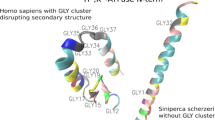Abstract
A model of the HKα2a subunit of the rabbit colonic H+, K+ ATPase has been generated using the crystal structure of the Ca+2 ATPase as a template. A pairwise sequence alignment of the deduced primary sequences of the two proteins demonstrated that they share 29% amino acid sequence identity and 47% similarity. Using O (version 7) the model of HKα2a was constructed by interactively mutating, deleting, and inserting the amino acids that differed between the pairwise sequence alignment of the Ca+2 ATPase and HKα2a. Insertions and deletions in the HKα2a sequence occur in apparent extra-membraneous loop regions. The HKα2a model was energy minimized and globally refined to a level comparable to that of the Ca+2 ATPase structure using CNS. The charge distribution over the surface of HKα2a was evaluated in GRASP and possible secondary structure elements of HKα2a were visualized in BOBSCRIPT. Conservation and placement of residues that may be involved in ouabain binding by the H+, K+ ATPase were considered and a putative location for the β subunit was postulated within the structure.
Figure Possible architecture of the HKα2a subunit. The residue in green is the lysine (position 517, Fig. 1) that lies in the nucleotide binding pocket and the residue in red is the aspartic acid at the phosphorylation site (position 385). Based on an alignment with the Ca+2 ATPase, ten transmembrane helices were modeled into HKα2a. The ten transmembrane helices are drawn as rods and shown in different colors for clarity. From left to right, the transmembrane helix designations are M10 (blue), M7 (gray), M8 (purple), M9 (orange), M5 (pink), M6 (green), M3 (brown), M4 (cyan), M2 (teal), and M1 (almond).








Similar content being viewed by others
References
Wingo CS, Cain BD (1993) Annu Rev Physiol 55:323–347
Palmgren MG, Axelsen KB (1998) Biochim Biophys Acta 1365:37–45
Rice WJ, Young HS, Martin DW, Sachs JR, Stokes DL (2001) Biophys J 80:2187–2197
Toyoshima C, Nakasako M, Nomura H, Ogawa H (2000) Nature 405:647–655
Zhang P, Toyoshima C, Yonekura K, Green NM, Stokes DL (1998) Nature 392:835–839
Hebert H, Purhonen P, Vorum H, Thomsen K, Maunsbach AB (2001) J Mol Biol 314:479–494
Thompson J, Higgins D, Gibson T (1994) Nucleic Acid Res 22:4673–4680
Jones TA, Zou JY, Cowan SW, Kjeldgaard M (1991) Acta Crystallogr A 47:110–119
Krogh A, Larsson B, von Heijne G, Sonnhammer EL (2001) J Mol Biol 305:567–80
Brunger AT, Adams PD, Clore GM, DeLano WL, Gros P, Grosse-Kunstleve RW, Jiang JS, Kuszewski J, Nilges M, Pannu NS, Read RJ, Rice LM, Simonson T, Warren GL (1998) Acta Crystallogr D Biol Crystallogr 54:905–921
Laskowski RA, MacArthur MW, Moss DS, Thornton JM (1993) J Appl Crystallogr 26:283–291
Nicholls A, Sharp KA, Honig B (1991) Proteins 11:281–296
(a) Esnouf RM (1997) J Mol Graph Model 15:132–134; (b) Esnouf RM (1997) J Mol Graph Model 15:112–113
Ettrich R, Melichercik M, Teisinger J, Ettrichova O, Krumscheid R, Hofbauerova K, Kvasnicka P, Schoner W, Amler E (2001) J Mol Model 7:184–192
Gibrat JF, Garnier J, Robson B (1987) J Mol Biol 198:425–443
Grishin AV, Bevensee MO, Modyanov NN, Rajendran V, Boron WF, Caplan MJ (1996) Am J Physiol 271:F539–551
Sweadner KJ, Donnet C (2001) Biochem J 356:685–704
Geering K, Crambert G, Yu C, Korneenko TV, Pestov NB, Modyanov NN (2000) Biochemistry 39:12688–12698
Colonna TE, Huynh L, Fambrough DM (1997) J Biol Chem 272:12366–12372
Campbell WG, Weiner ID, Wingo CS, Cain BD (1999) Am J Physiol 276:F237–245
Fejes-Toth G, Naray-Fejes-Toth A, Velazquez H (1999) Kidney Int 56:1029–1036
Or E, Goldshleger R, Karlish SJ (1999) J Biol Chem 274:2802–2809
Hasler U, Crambert G, Horisberger JD, Geering K (2001) J Biol Chem 276:16356–16364
Acknowledgements
This work was supported by Public Health Service Grant No. RO1-54721.
Author information
Authors and Affiliations
Corresponding author
Rights and permissions
About this article
Cite this article
Gumz, M.L., Duda, D., McKenna, R. et al. Molecular modeling of the rabbit colonic (HKα2a) H+, K+ ATPase. J Mol Model 9, 283–289 (2003). https://doi.org/10.1007/s00894-003-0140-2
Received:
Accepted:
Published:
Issue Date:
DOI: https://doi.org/10.1007/s00894-003-0140-2




